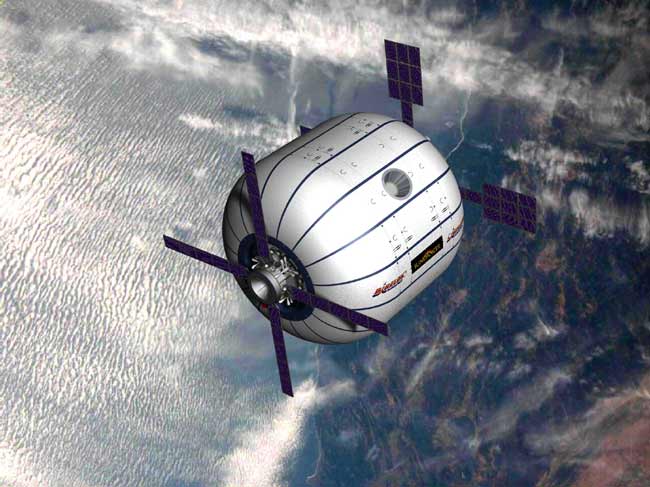Bigelow Aerospace Wants Atlas 5 Rockets for New Space Station

WASHINGTON -- Bigelow Aerospace officials saidFeb. 1 they are making progress in their negotiations with Lockheed MartinCommercial Launch Services for six initial launches for their plannedcommercial space station, starting around 2011. Subsequently the company hopesto conduct as many as a dozen Atlas 5 launches per year as the new facilitybecomes fully operational.
BigelowAerospace and United Launch Alliance (ULA) -- the Denver-based company thatbuilds the Atlas 5 Services -- have been working together for over a yearstudying what it would take to human-rate the Atlas 5 rocket. Industry sourcessaid Bigelow Aerospace is ready to place an order that includes six launchesstarting in 2011 to beginassembly and early operation of the new station.
?Those[first] six launches will be comprised of two missions to deploy hardware suchas Sundanceritself and our node/bus combination and four missions dedicated totransporting crew and cargo,? Robert Bigelow, president and founder of BigelowAerospace said in a written statement. ?Subsequently our launch rate willdouble, and we will require a dozen launches, all for crew and cargotransportation missions over the next 12-month period. Our third year of activeoperations will again require another dozen crew and cargo mission launchesand, in our fourth year of operations, we anticipate needing 18 such launches.?
Bigelowsaid the negotiations with Lockheed Martin apply only to the provision of aman-rated launch vehicle and that the type and manufacturer of the crewtransport capsule Bigelow will need has yet to be decided.
?I don?tthink anyone could deny the excellent record and pedigree of the Atlas 5-401 asa quality choice to be upgraded to carry human passengers,? Bigelow said.
ULAspokeswoman Julie Andrews also confirmed Feb. 1 that negotiations were underway.
?As amerchant supplier of launch services, United Launch Alliance is very proud thatour Atlas 5 is being considered for such a commercial space venture,? Andrewstold Space News. ?We will work closely with Lockheed Martin Commercial LaunchServices in implementing the detailed design and development activities toprovide a human-rated Atlas 5 launch vehicle to be ready to support Bigelow's plan.?
Breaking space news, the latest updates on rocket launches, skywatching events and more!
While ULAwould supply the rockets, the deal is being worked through Lockheed MartinCommercial Launch Services, also of Denver.
In awritten statement, David Markham, president of Lockheed Martin CommercialLaunch Services, said: ?The Atlas 5 is ideal to provide commercial crew andcargo transportation for this pioneering commercial space venture.
BigelowAerospace possesses an unparalleledvision and entrepreneurial perspective thatis crucial to truly opening the commercial space market to a larger segment ofthe population. Targeting the Atlas 5 for use demonstrates a commitment toflight-proven domestic launch services to ensure success.?
Andrewssaid ULA is still evaluating what it would need to do on the production side tosupport the 12 launches per year Bigelow says he wants.
?We willstudy how to increase the production rate for the eventual rates that Bigelowis talking about,? she said.
On theoperations side of the equation, Andrews said the Atlas 5 launch complex atCape Canaveral Air Station in Florida issized to handle the number of launches Bigelow is talking about.
?We will bekeeping all of our government customers informed as we go forward, but LaunchComplex 41 was designed to launch more than they currently are,? Andrews said,noting that Lockheed Martin conducted 11 Atlas 1 and 2 launches from Florida in1995.
BigelowAerospace currently has two subscale expandable space modules in orbit. Theprivately-financed Genesis1 and Genesis 2 modules were launched on July 12,2006 and June 28, 2007, respectively, on Dnepr boosters from the ISC KosmotrasYasny Cosmodrome, located in the Orenburg region of Russia.
Last yearBigelow cited the combination of rising Russian launch prices and the successof Genesis 1 and 2 in announcing his plans to skip the launch of additionalsubscale demonstrators and accelerate the deployment of an expandable spacestation initially capable of accommodating six people and eventually as many as15.
Hisadvertised price for a four-week stay: just under $15 million.
Bigelow didnot disclose what type of spacecraft the company intends to put atop the Atlas5 to carry passengers.
Editor's Note: This story was updated on Feb. 6, 2007.
- VIDEO: Robert Bigelow: Lessons, Visions and Realities of Commercial Space
- VIDEO: More on Bigelow Aerospace's Inflatable Modules and Space News TV.
- Bigelow Aerospace Aims for an International Market
Brian Berger is the Editor-in-Chief of SpaceNews, a bi-weekly space industry news magazine, and SpaceNews.com. He joined SpaceNews covering NASA in 1998 and was named Senior Staff Writer in 2004 before becoming Deputy Editor in 2008. Brian's reporting on NASA's 2003 Columbia space shuttle accident and received the Communications Award from the National Space Club Huntsville Chapter in 2019. Brian received a bachelor's degree in magazine production and editing from Ohio University's E.W. Scripps School of Journalism.
